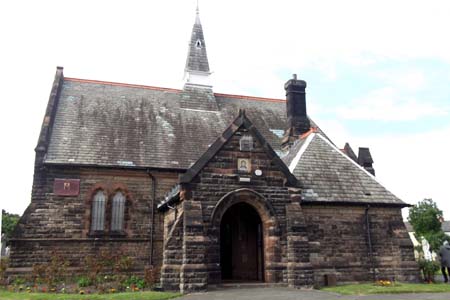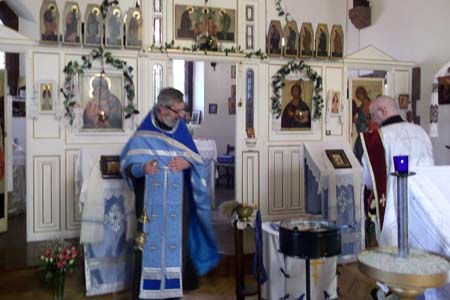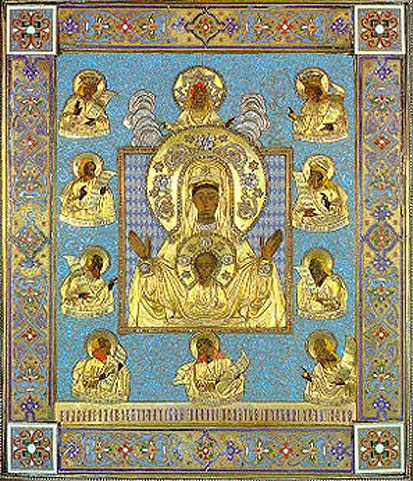| |
 |
 |
 |
| Comment on this report, or find other reports. |
 |
| Our Mystery Worshippers are volunteers who warm church pews for us around the world. If you'd like to become a Mystery Worshipper, start here. |
 |
| Find out how to reproduce this report in your church magazine or website. |
|
|
| 2705: St Elisabeth the New Martyr, Wallasey, UK |
 |
 |
 |
Mystery Worshipper: Torold.
The church: St Elisabeth the New Martyr, Wallasey, England.
Denomination: Russian Orthodox Church Outside of Russia, Diocese of Great Britain and Ireland.
The building: Formerly a cemetery chapel, built for the people of Wallasey in 1883, used until 2006 though latterly infrequently. It consisted of a mortuary on its north side, now the library; the main chapel, once full of pews; a porch and a vestry, now the kitchen and wc. It was bought by the Russian Orthodox parish, who took over responsibility for it in July 2009. The style is Victorian Gothic Revival: limestone under a slated roof. As one enters the building from the side porch, one notices first the iconostasis – a screen across the sanctuary not unlike a large wardrobe, painted white and bedecked with flowers in swags, with doors either side and in the middle. Beautiful painted icons are fixed on to it of the evangelists and the Annunciation. The archangels are on the side doors. The doors open for processions. A large circular icon known as the Pokrov (Protection of the Mother of God) is found above. Behind the iconostasis stands the holy table with a seven-branched candle stick; from here the priest conducts the divine liturgy (holy communion). Four bells of different sizes hang from the wall, bells that ring during the creed, or welcoming a bishop, or at Easter. The icon of St Elisabeth, patron of the parish, stands on the left. One next notices the Victorian floor tiles, striking in design and colour, and a vase of roses, peonies and gypsophilla that stood on the window sill. The library contains many books and is housed in the former mortuary chapel on the north side. It has glazed windows and is made of cast iron painted white.
The church: The parish began in 1993 as a small house chapel in the home of the parish priest. However, it soon outgrew the house chapel and had to find larger premises. St Elisabeth was the grand-daughter of Queen Victoria and was chosen as patron after converting to Russian Orthodoxy following her marriage into the Russian Royal Family. She became a nun after the assassination of her husband, Tsar Nicholas, and was martyred by the Bolsheviks in 1918, the day after the murder of the Tsarís immediate family. A small portion of her relics rest in the church. In keeping with the traditional purpose of the building, the parish makes the chapel available for funerals of any persons who (quoting from their website) "profess faith in the Holy and Undivided Trinity." The chapel also hosts book fairs, performances and exhibitions provided that persons be "respectful of the primary purpose of this church, which is the worship of God by his people."
The neighbourhood: Wallasey, near Liverpool, consists of the usual high street shops and department stores, eateries and bars. The UK's first guide dog training school, the Guide Dogs for the Blind Association, was founded here in 1931. Rake Lane Cemetery, where the chapel is sited, is vast and contains some interesting monuments, many connected with major maritime disasters of the early 20th century, including Titanic and Lusitania. It lies within the residential suburb of Liscard, bordering on the banks of the River Mersey. The Beatles played some of their first shows outside Liverpool at the Grosvenor Ballroom in Liscard in 1960.
The cast: The only person named was the Revd Father Paul Elliot, rector. Also in attendance were assorted robed clergy and laity (I couldnít tell them apart). No names were given.
The date & time: Friday, 6 June 2014, 6.00pm.
Comment:
We have received a comment on this report.
What was the name of the service?
Akathist (Hymn of Praise) to the Kursk Icon of the Mother of God Ė Welcoming the Icon and Singing the Liturgy.
The Kurst Root Icon was discovered in 1295 by a hunter near the Russian town of Rylsk. As the hunter lifted the icon up from the ground, a spring of water burst forth from the spot. Hundreds of miracle cures are attributed to this ancient Russian icon and to the waters of the spring, including curing St Seraphim of Sarov of a childhood illness that had brought him to the brink of death. The icon normally resides in New York and is greeted by thousands of people whenever it returns to its native homeland. The icon first visited Wallasey in May 2012.
How full was the building?
Full to bursting, about 200.
Did anyone welcome you personally?
Father Elliot himself was bustling about setting up shop, but he took time to greet me upon arrival, saying: "The icon will be here at ten to six. Please stay; you are welcome. It is coming by taxi from the airport."
Was your pew comfortable?
What pew? There are no seats apart from a handful of folding chairs and a few benches scattered around the edges of the building. These, however, were already occupied. In the Orthodox tradition, the faithful stand up for the entire service. Apparently, standing gets easier "in time." I was desperate to park my bum.
How would you describe the pre-service
atmosphere?
Quite a few people were wandering around, bowing and crossing themselves three times and bowing to the floor. They were also lighting thin brown tapers and kissing the icons that lined the walls and every available surface in the little chapel. All had a small votive light in front of them that somebody was busy putting a match to. The icons are varied: some old, some newer, some coloured, some sepia tinted. They look timeless and are devotional aids. They are all treated with great respect, a bit like having family photographs about the place.
What were the exact opening words of the
service?
"Reverend Fathers, Reverend Mother, brothers and sisters: welcome to you and welcome to the Kursk Root Icon this evening."
What books did the congregation use during the
service?
Service sheets had been doing the rounds, also a music print-out of part of the liturgy. I had one of these but not the service sheet, which would have been handy as it contained the text of the psalm/prayers, etc. It seems they had not expected a full house. I was able to peer over the shoulder of the person in front of me and squint at their service sheet. Trouble was, my specs were in the car!
What musical instruments were played?
None. But a small choir of ladies on the north side of the chapel led the singing. The robed male cantor sang very rapidly! The congregation joined in the responses and the alleluias, of which there were many.
Did anything distract you?
It sure did! I wanted to sit down desperately. Iím not very good at standing for an hour and a quarter in cramped surroundings wondering whatís going to happen next. Also, I noticed an enormous cobweb draped across the window behind me.

Was the worship stiff-upper-lip, happy clappy, or
what?
It had a style of its own. It was completely different from anything I had ever experienced before. The Kurst Root Icon had been censed on arrival and rose petals strewn before it with reverence on its way into the chapel. But no one seemed particularly happy or joyful; I looked at peopleís faces and their eyes were fixed straight ahead, unsmiling, unblinking, standing stock still. Or the lucky ones sitting down.
Exactly how long was the sermon?
There was no sermon.
Which part of the service was like being in
heaven?
I liked the style of the music. I enjoyed the singing: it had a soporific effect, somewhat like a mantra repeated over and over. And it went on and on!
And which part was like being in... er... the other place?
Oh, my poor legs! My varicose veins were letting me know about it!
What happened when you hung around after the service looking lost?
The service ended with the veneration of the icon. We were invited to come forward and touch the framed icon, which is very lovely, and kiss it. Father Elliot said that we were all welcome to be anointed, Orthodox or not, which he did with a small gold paint brush across the forehead. Those who availed themselves of this were also given a Kursk Root Icon booklet. I declined, but inspected the icon and touched it with my clean folded handkerchief. Then I sank gratefully into a recently vacated seat, still warm from the previous occupant. Bliss! Someone spoke to me, saying, "Oh hello. Donít I know you?" I did not recognise the person; in fact, I was not who they thought I was.
How would you describe the after-service
coffee?
There was no coffee and the party was breaking up anyway, with people trying to make a rush for the one and only door. Difficult when one is standing ten-deep. The chapel must surely be seen as a fire risk, but I kept calm and didnít panic. I gathered up some of the rose petals to press when I got home.
How would you feel about making this church your regular (where 10 = ecstatic, 0 = terminal)?
5 – I would like to be generous to other people's traditions, but this is a different style of worship from the ones I am used to. However, it is not for the faint hearted!

Did the service make you feel glad to be a
Christian?
Yes, because it was good to sample another form of worship even if it was rather hard to comprehend.
What one thing will you remember about all this in seven days' time?
The cobweb across the window. |
|
|
 |
 |
 |
| We rely on voluntary donations to stay online. If you're a regular visitor to Ship of Fools, please consider supporting us. |
 |
 |
 |
| The Mystery Pilgrim |
 |
| One of our most seasoned reporters makes the Camino pilgrimage to Santiago de Compostela in Spain. Read here. |
 |
 |
 |
| London churches |
 |
| Read reports from 70 London churches, visited by a small army of Mystery Worshippers on one single Sunday. Read here. |
| |
|
|
|
|


